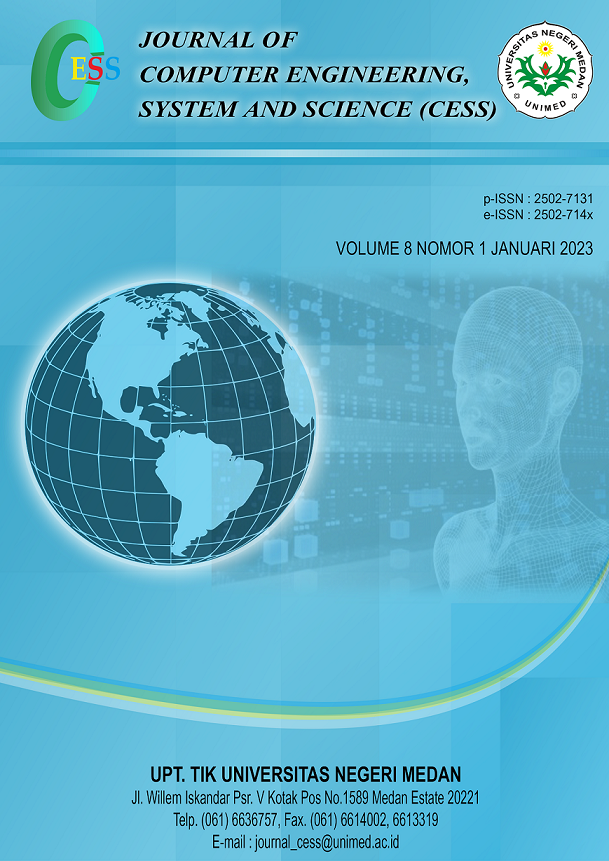SARS-CoV-2 Detection from Lung CT-Scan Images Using Fine Tuning Concept on Deep-CNN Pretrained Model
DOI:
https://doi.org/10.24114/cess.v8i1.40897Keywords:
SARS-CoV-2 detection, lung CT-Scan imaging, deep-CNN pretrained model, fine tuningAbstract
The problem of the spread of COVID-19 (SARS-CoV-2) is spreading fleetly and worldwide. Beforehand discovery and opinion of complaint is veritably important to ensure the right remedy so that it needs to be enforced through various practical approaches. In former studies, complaint discovery through medical imaging has started to appear and get a good delicacy of around 80 to 90 percent using machine learning. In the deep learning era, some trials get better accuracy of 95 percent using the traditional deep learning approach. Now, deep learning has developed more fleetly, especially for image classification. therefore, it's necessary to experiment with a pretrained model approach to medical images. In addition, the fine tuning approach will also be an aspect of the approach that will be carried out in this trial to be compared and to find out its effect, specifically on CT-Scan images of the lungs for the discovery of COVID 19. The results of this experiment showed that the pretrained model approach can get high accuracy. Relatively high accuracy, the smallest testing accuracy in this trial reached 94.78 percent of the Xception without fine tuning phase, this result has beaten the machine learning approach which is didn't reach 90 percent of accuracy. The best experiment testing accuracy get 97.59 percet on the VGG 16 by applying fine tuning. The results of this trial also show that the fine tuning stage (for the top 10th layers) can increase the accuracy of the model.References
C. Sohrabi, Z. Alsafi, N. O. Neill, M. Khan, and A. Kerwan, œWorld Health Organization declares global emergency: A review of the 2019 novel coronavirus (COVID-19), no. January, 2020.
T. Ai et al., œCorrelation of Chest CT and RT-PCR Testing for Coronavirus Disease 2019 (COVID-19) in China: A Report of 1014 Cases, Radiology, vol. 296, no. 2, pp. E32“E40, 2020, doi: 10.1148/radiol.2020200642.
T. B. Chandra and K. Verma, œPneumonia Detection on Chest X-Ray Using Machine Learning Paradigm, Proc. 3rd Int. Conf. Comput. Vis. Image Process. Adv. Intell. Syst. Comput., vol. 1022, 2018.
J. Diaz-Escobar et al., œDeep-learning based detection of COVID-19 using lung ultrasound imagery, PLoS One, vol. 16, no. 8 August, pp. 1“21, 2021, doi: 10.1371/journal.pone.0255886.
V. Shah, R. Keniya, A. Shridharani, M. Punjabi, J. Shah, and N. Mehendale, œDiagnosis of COVID-19 using CT scan images and deep learning techniques, Emerg. Radiol., vol. 28, no. 3, pp. 497“505, 2021, doi: 10.1007/s10140-020-01886-y.
S. Sharma, œDrawing insights from COVID-19-infected patients using CT scan images and machine learning techniques: a study on 200 patients, Environ. Sci. Pollut. Res., vol. 27, no. 29, pp. 37155“37163, 2020, doi: 10.1007/s11356-020-10133-3.
M. J. Horry et al., œCOVID-19 Detection through Transfer Learning Using Multimodal Imaging Data, IEEE Access, vol. 8, pp. 149808“149824, 2020, doi: 10.1109/ACCESS.2020.3016780.
D. A. Zebari, A. M. Abdulazeez, D. Q. Zeebaree, and M. S. Salih, œA Fusion Scheme of Texture Features for COVID-19 Detection of CT Scan Images, 3rd Int. Conf. Adv. Sci. Eng. ICOASE 2020, pp. 12“17, 2020, doi: 10.1109/ICOASE51841.2020.9436538.
S. A. Harmon et al., œArtificial intelligence for the detection of COVID-19 pneumonia on chest CT using multinational datasets, Nat. Commun., vol. 11, no. 1, pp. 1“7, 2020, doi: 10.1038/s41467-020-17971-2.
J. C. Hung, K. C. Lin, and N. X. Lai, œRecognizing learning emotion based on convolutional neural networks and transfer learning, Appl. Soft Comput. J., vol. 84, p. 105724, 2019, doi: 10.1016/j.asoc.2019.105724.
H. Panwar, P. K. Gupta, M. K. Siddiqui, R. Morales-Menendez, and V. Singh, œApplication of deep learning for fast detection of COVID-19 in X-Rays using nCOVnet, Chaos, Solitons and Fractals, vol. 138, p. 109944, 2020, doi: 10.1016/j.chaos.2020.109944.
F. Chollet, œXception: Deep learning with depthwise separable convolutions, Proc. - 30th IEEE Conf. Comput. Vis. Pattern Recognition, CVPR 2017, vol. 2017-January, pp. 1800“1807, 2017, doi: 10.1109/CVPR.2017.195.
K. Simonyan and A. Zisserman, œVery deep convolutional networks for large-scale image recognition, 3rd Int. Conf. Learn. Represent. ICLR 2015 - Conf. Track Proc., pp. 1“14, 2015.
E. Soares and P. Angelov, œA large dataset of real patients CT scans for COVID-19 identification, Harv. Dataverse, vol. 1, pp. 1“8, 2020.
D. M. W. Powers, œEvaluation: from precision, recall and F-measure to ROC, informedness, markedness and correlation, no. January 2008, 2020, [Online]. Available: http://arxiv.org/abs/2010.16061.
Downloads
Published
Issue
Section
License
Copyright (c) 2023 CESS (Journal of Computer Engineering, System and Science)

This work is licensed under a Creative Commons Attribution 4.0 International License.










